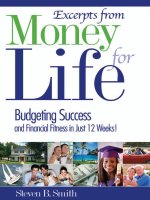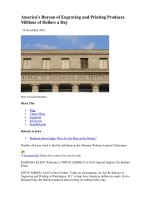uniit money
Bạn đang xem bản rút gọn của tài liệu. Xem và tải ngay bản đầy đủ của tài liệu tại đây (249.19 KB, 9 trang )
Money
Contents
1.
2.
3.
4.
5.
6.
Recording Money
Adding & subtracting money
Multiplying money
Dividing money
Forms
Buying on credit
Recording Money
Prices can be marked on goods, or spoken, in different ways, for example:
Money written in figures is always written with two decimal places.
The decimal point marks the end of the whole numbers, and the two columns on the right are for the pence.
Price A above would be recorded as £60.00, using two trailing zeroes to record that there are no pence.
The items in example B would be recorded as £0.65, £0.70 and £1.00. The leading zero is used when
there are no whole numbers. C would be recorded as £2.05, not as £2.5. The zero here is a place holder,
so that the value of the five goes in the correct column (it is 5 hundredths).If you use a calculator for money
questions, you need to know that it will not add trailing zeroes, so an answer of twenty pounds
sixty pence would appear as 20.6; you need to record it as 20.60.
Adding & subtracting money
To add or subtract money values you must:
•record amounts to two decimal places, putting in extra zeroes if needed
•line up the decimal points so they are underneath each other
•start your calculation from the right
Example 1
Liz bought a newspaper for 50p, a drink for one pound five pence and a sandwich for
£2.25. How much did she spend altogether?
She spent £3.80
Example 2
A power tool costs £42.95 on special offer in store A and £65.75 in store B. How much do you save if you buy it
from store A?
(This shows the traditional method; use whatever method you like best.)
Exercise One
Multiplying Money
When multiplying money:
•Record the money correctly, using two decimal places. (You may need to add some zeroes.)
•Carry out the multiplication ignoring the decimal point and starting from the right.
•Put a decimal point into your answer so that it has two decimal places.
Example 1
Jean bought 12 books at £1.35 each. What was the total cost?
Example 2
Leon bought eight items at £3.65 each. He did this written calculation:
Dividing Money
Record the amount correctly to two decimal places.
•Put a decimal point above the one in your sum of money.
•Start from the left.
Example 1
Five pens cost £3.85. How much did one cost?
Each one cost £0.77 (77p)
Dividing decimals can sometimes give you a long string of numbers. In this case, work as far as three decimal
places and then round the second place up or down.
If the last figure is five or more, round up. If it is less than five, round down. (If you need help with this look at
factsheet 4 in Numbers: Decimals Continued.)
Example 2
Jimmy paid £70 for 6 tickets at a special offer price. His five friends shared the cost with him. How much did each
ticket cost?
Because the third decimal place is a six, round up. The cost is £11.67 to the nearest penny.
Forms
Here are some examples of forms using money calculations.
Example 1
Here is part of Euan's Council tax bill for the year.
He checks the figures. The total for the 9 payments of £84 is
9 x £84 = £756
Adding this to the first payment he gets
£756.00 + £82.77 = £838.77
This is the total shown on the bill so it's correct at £838.77
Buying on Credit
Buying on credit and paying in instaments usually means you pay more than if you pay the full price in one payment.
It's useful to be able to check how much extra it will cost you.
Example 1
A fire with surround costs £299 in a DIY store. The credit charge is 36 payments of £12.60 a month.
How much extra do you pay when you buy on credit?
The total of the monthly payments is 36 times £12.60
The difference between the cost and the payments is £453.60 - £299.00
So you pay £154.60 more than the original price.









